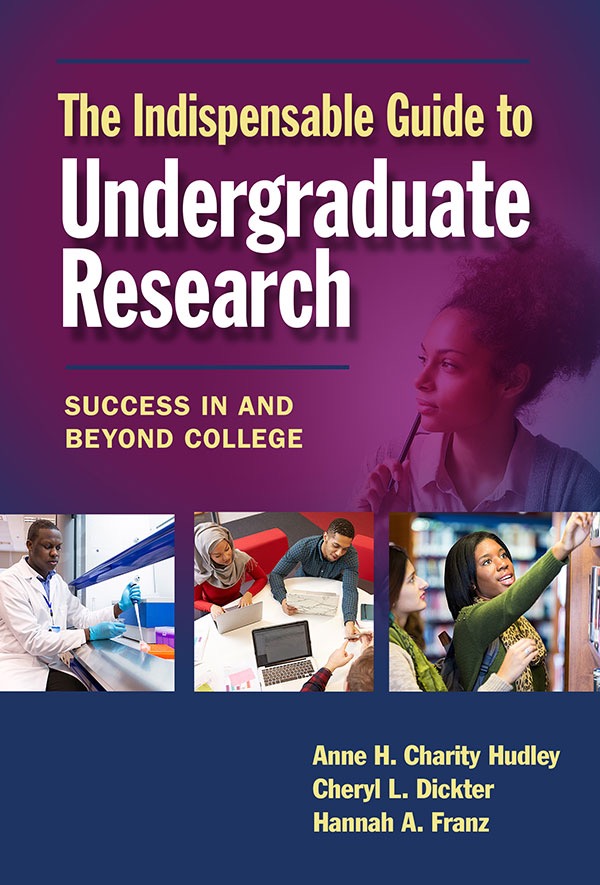critical thinking
Select an item by clicking its checkbox

The Indispensable Guide to Undergraduate Research - Success in and Beyond College
Date Reviewed: April 16, 2018
This brief handbook and reference work was designed for college and university students interested in doing research. Charity Hudley, Dickter, and Franz present scholarly research as an exciting way for undergraduates to make the transition from students who learn to scholars who join an ongoing conversation as “masters of knowledge and challengers of the status quo” (5). The authors purposely construct the guide to serve not only as a resource but also as a model of a research-based approach to scholarly writing; they frequently comment on their own working methods and the research process that went into the composition of this text. The resulting book effectively demystifies the world of academia and the work of scholars, making research approachable and appealing.
Throughout the guide, the authors encourage students to pursue their academic and personal interests by becoming researchers, and they provide an impressively comprehensive roadmap for the research process. The book takes a special interest in guiding first-generation college students and students from historically underrepresented populations. The tone is collegial, and the text abounds with concrete advice about navigating the concomitants of scholarly research, from how to email a potential research mentor (80) to how to identify and access campus resources that can assist with time and energy management (49). Chapter 2, devoted to getting started, describes what research looks like across several academic disciplines and details ways different schools support and reward undergraduate research. Personal accounts from student scholars provide additional relatable voices and create the sense of a broad academic community into which readers are invited. The authors also emphasize the importance of sharing research results with a variety of audiences; Chapter 5, “Writing and Presenting Research” (91-116), describes different venues for written and oral communication that increase the impact of a student’s project, including conferences, articles, books, and social media.
A particularly valuable contribution of this book is its focus on empowering students from underrepresented populations. In addition to devoting a chapter to describing challenges that students from minority populations face and some tools for overcoming those challenges (“Underrepresented Scholars in the Academy: Making a Way,” [117-142]), the authors consistently highlight the value of diverse voices and backgrounds, and especially of the new questions such diverse viewpoints can generate. They frame the importance of greater academic inclusiveness and equity in a larger conversation about the powerful impacts researchers can have on their communities, emphasizing the value of interdisciplinary scholarship and community-based research.
Although the book is addressed directly to an audience of undergraduates who are or who seek to become researchers, the authors also model numerous ways to offer such students practical support. Therefore the text may also serve as a valuable resource for teachers, mentors, and advisors who assist student researchers and ensure their success.
My most recent post for “Teaching Islam” deals with some of the stakes in teaching and studying religion at a Catholic college. My colleagues Shabana Mir and Sherali Tareen have also provocatively and sharply addressed related topics of “confessional” and “secular” curricular methodologies, so I’d like to continue the ...
 NOTE: Use the playlist button located in the top left of the video window above to switch between episodes.
NOTE: Use the playlist button located in the top left of the video window above to switch between episodes.
Problem-Based learning at Maastricht University (4:38)
Although a promotional spot for prospective students, this video nicely details goals, roles, stages, and terms common in “problem-based learning.”
Project Based Learning: Explained (3:49)
Through examples, the video promotes this method’s educational value and capacity to develop critical thinking, cooperation, and communication.
Problem-Based Learning at SIU PA Program (11:25)
Goals, roles, and stages (including self-assessment) of problem-based learning demonstrated through a case study approach to physician assistant training. Video emphasizes the active learning dimension of problem-based learning.
 NOTE: Use the playlist button located in the top left of the video window above to switch between episodes.
NOTE: Use the playlist button located in the top left of the video window above to switch between episodes.
What is Critical Thinking? (10:42)
With amusing references to pop culture, a philosopher distills the key attributes of critical thinking, offers his own best definition, and expounds why critical thinking should be taught. (10:42)
5 Tips to Improve Your Critical Thinking? (4:30)
This TED.Ed video describes a 5-Step Process for using critical thinking to improve decision-making: Formulate Your Question, Gather Your Information, Apply the Information, Consider the Implications, Explore Other Points of View.
The University of Chicago made news recently because of a letter sent by its Dean of Students to inform its incoming class of freshmen that the University, given its commitment to “freedom of inquiry and expression,” does not support “trigger warnings,” cancel controversial speakers, or condone creation of “safe spaces.” ...

